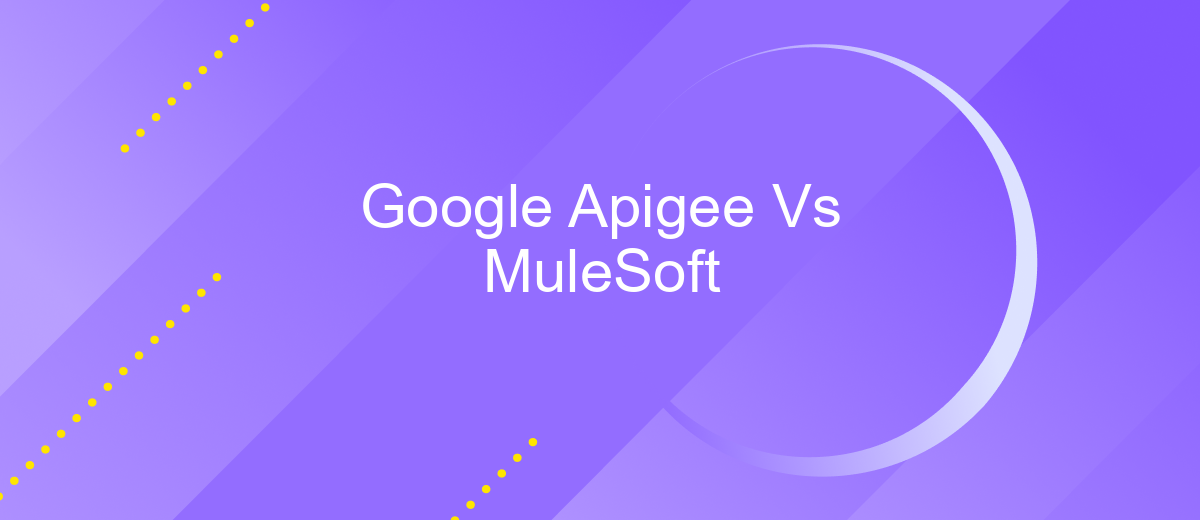Google Apigee Vs MuleSoft
In the rapidly evolving landscape of API management, choosing the right platform is crucial for seamless integration and efficient data flow. Google Apigee and MuleSoft are two leading contenders in this space, each offering unique features and capabilities. This article delves into a comparative analysis of Google Apigee and MuleSoft, helping you make an informed decision for your business needs.
Introduction
In today's digital landscape, businesses rely heavily on integration platforms to streamline their operations and enhance connectivity between various systems. Two prominent players in this domain are Google Apigee and MuleSoft, each offering unique capabilities to meet diverse integration needs. As organizations strive to improve efficiency and agility, understanding the strengths and differences of these platforms becomes crucial.
- Google Apigee: Known for its robust API management capabilities, Apigee provides comprehensive tools for designing, securing, and monitoring APIs.
- MuleSoft: Renowned for its versatile Anypoint Platform, MuleSoft excels in connecting applications, data, and devices, offering a unified solution for integration.
- ApiX-Drive: An emerging player, ApiX-Drive simplifies the integration process with its user-friendly interface, making it accessible for businesses of all sizes.
This article delves into a detailed comparison of Google Apigee and MuleSoft, highlighting their key features, advantages, and potential use cases. By examining these platforms, businesses can make informed decisions to choose the right integration solution that aligns with their specific requirements and goals.
Features and Capabilities

Google Apigee offers a robust API management platform that includes features such as API analytics, developer portals, and security protocols. It excels in providing real-time insights and monitoring capabilities, enabling businesses to optimize their API performance. Apigee also supports seamless integration with Google Cloud services, which enhances its scalability and reliability. Additionally, its user-friendly interface simplifies the process of creating, deploying, and managing APIs.
MuleSoft, on the other hand, is known for its comprehensive integration capabilities, facilitating the connection of various applications, data, and devices. It offers a unified platform for API management, integration, and automation, making it a versatile choice for complex enterprise environments. MuleSoft's Anypoint Platform provides pre-built connectors and templates, which streamline the integration process. For those looking to enhance their integration efforts, services like ApiX-Drive can be a valuable addition, offering automated workflows and seamless data synchronization across multiple platforms.
Pricing and Licensing

When comparing the pricing and licensing models of Google Apigee and MuleSoft, it's important to consider the specific needs of your organization. Google Apigee offers a flexible pricing model that includes a free tier for small projects and scalable pricing based on the number of API calls and additional features. This makes it suitable for startups and enterprises alike.
- Google Apigee: Free tier available, with paid plans starting based on API call volume and additional features.
- MuleSoft: Offers a subscription-based pricing model, with different tiers based on the number of users, environments, and additional services.
MuleSoft, on the other hand, provides a more traditional subscription-based pricing model, where costs depend on the number of users and environments. Both platforms offer robust integration capabilities, but if you need an external service to help with integration, consider using ApiX-Drive. ApiX-Drive simplifies the process of connecting various applications and automating workflows, which can be a valuable addition to either platform.
Pros and Cons

When comparing Google Apigee and MuleSoft, both platforms offer robust API management solutions, but they have distinct advantages and disadvantages. Google Apigee is known for its strong analytical capabilities and seamless integration with Google Cloud services. On the other hand, MuleSoft's Anypoint Platform excels in its comprehensive integration capabilities, making it a preferred choice for complex enterprise environments.
One of the key strengths of Google Apigee is its user-friendly interface and extensive documentation, which make it easier for developers to get started. MuleSoft, however, provides a more flexible architecture that supports a wide range of integration scenarios, including on-premises, cloud, and hybrid environments.
- Google Apigee Pros: Strong analytics, seamless Google Cloud integration, user-friendly interface.
- Google Apigee Cons: Can be complex to set up for non-Google Cloud users, higher cost.
- MuleSoft Pros: Comprehensive integration capabilities, flexible architecture, strong community support.
- MuleSoft Cons: Steeper learning curve, potentially higher costs for smaller businesses.
For businesses looking to simplify their integration processes, services like ApiX-Drive can be invaluable. ApiX-Drive offers a straightforward way to connect various applications and automate workflows, complementing the capabilities of both Google Apigee and MuleSoft. This can be particularly beneficial for organizations that need to integrate multiple systems without extensive coding.
Conclusion
In conclusion, both Google Apigee and MuleSoft offer robust solutions for API management and integration, each with its own set of strengths. Google Apigee excels in providing advanced analytics, security features, and seamless integration with other Google Cloud services. On the other hand, MuleSoft stands out with its versatile Anypoint Platform, which offers a comprehensive suite of tools for API design, implementation, and management, making it a strong choice for enterprises with diverse integration needs.
When deciding between the two, organizations should consider their specific requirements, existing infrastructure, and long-term goals. For businesses looking to simplify and automate their integration processes, leveraging services like ApiX-Drive can provide additional flexibility and efficiency. Ultimately, the best choice will depend on the unique context and objectives of the organization, ensuring that the chosen platform aligns well with their strategic vision and operational demands.
FAQ
What are the primary differences between Google Apigee and MuleSoft?
Which platform is better for large-scale enterprises?
How do Google Apigee and MuleSoft handle security?
Can I use these platforms for automating workflows and integrations?
What is the learning curve like for Google Apigee and MuleSoft?
Routine tasks take a lot of time from employees? Do they burn out, do not have enough working day for the main duties and important things? Do you understand that the only way out of this situation in modern realities is automation? Try Apix-Drive for free and make sure that the online connector in 5 minutes of setting up integration will remove a significant part of the routine from your life and free up time for you and your employees.

